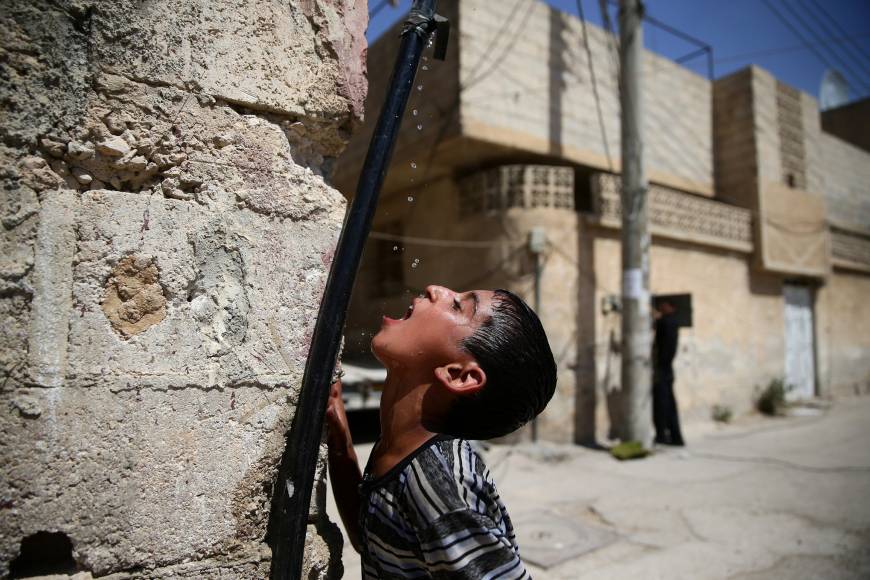The Japan Times
The United Nations now estimates there are 5 million Syrians in need of humanitarian aid living in hard-to-reach areas, nearly a million more than the previous figure.
Stephen O’Brien, the U.N.’s emergency relief coordinator, told the Security Council on Thursday that the increase of 900,000 people over the previous estimate of 4.1 million people in April was mainly due to growing insecurity in a number of areas.
“This large increase is based on several factors, but primarily the inclusion of areas in parts of Aleppo, Raqqa and Hasakeh governorates as a result of insecurity, as well as constrained access for humanitarian actors,” O’Brien said.
O’Brien also flagged continuing attacks on hospitals and medical facilities in Syria as violations of international law and Security Council resolutions.
He said that Physicians for Human Rights documented 365 attacks on 259 medical facilities as of late April, with 76 percent of attacks attributed to Syrian government forces. He said the U.N. has received reports of many more attacks on medical facilities since then
“There is something fundamentally wrong in a world where attacks on hospitals and schools, on mosques and public markets, on ethnic religious and confessional groups have become so commonplace that they cease to incite any reaction,” O’Brien said.
O’Brien said that since January, the U.N. and its partners have been able to reach some 844,325 Syrians in besieged and hard-to-reach areas with humanitarian aid, some of them more than once.
“While this certainly represents progress and is welcomed, it is but a trickle compared to the level of protection concerns, needs and suffering in besieged and hard-to-reach areas,” he said.
The U.N. is now asking for access to reach over 1.2 million in 35 besieged and hard-to-reach areas in July, O’Brien said, calling on the Syrian government that it be “approved in full and without any conditions.”
O’Brien dedicated his remarks Thursday to Jo Cox, the British lawmaker killed last week, who he said had “worked relentlessly, courageously, effectively,” for the innocent people of Syria
Speaking to reporters following a Security Council meeting, Syria’s Ambassador Bashar Jaafari blamed Turkey, Saudi Arabia, Qatar and Western powers for increasing the suffering of the Syrian population.
“The imposition of economic unilateral, coercive measures is adding to the dramatic scene within Syria right now, these Western capitals should understand that they can help the Syrian people, averting the humanitarian suffering, by lifting these economic sanctions imposed The U.N. meanwhile said Thursday it would begin flying desperately needed aid from Damascus to the northeastern Syrian city of Qamishli, which has been inaccessible by domestic roads for more than two years.
“We are just about to launch an air bridge into Qamishli from Damascus,” the U.N.’s humanitarian coordinator for Syria, Yacoub El Hillo, told reporters.
“The reason for this is that we have run out of meaningful means to reach people over land,” he said, adding that the airlift “…will bring life-saving assistance to a very large number of people.”
Qamishli, near the Turkish border, lies in Hasakeh governorate, which can only be reached by road in Syria by driving through the governorates of Raqqa and Deir Ezzor, which are dominated by the Islamic State group.
“They haven’t been reached by land from within the country since early 2014,” said Bettina Luescher, spokeswoman for the U.N.’s World Food Program (WFP), which will coordinate the operation.
Some 1,000 tons of relief items — consisting 70 percent of food — will be flown in to a nearby airport and distributed in the town, Luescher said.
She said the aim during the first month was to feed 150,000 people.
The U.N. previously set up an airlift to bring aid to Qamishli in 2014, and has also delivered assistance across the border from Turkey, but the main border crossing has been closed since the beginning of the year.
Qamishli is far from the only part of war-ravaged Syria desperate for aid.
Jan Egeland, head of a U.N.-backed international humanitarian task force for the war-ravaged country, told reporters that aid workers were still struggling to reach all of Syria’s 18 besieged areas ± most of them encircled by government forces or their allies.
Since the beginning of the year, aid has been delivered at least once to 16 of those areas, but Erbin and Zamalka in rural Damascus have gone without potentially life-saving assistance since November 2012.
“We hope to reach them next week,” Egeland said, adding that the sticking point was a disagreement over how many people are inside the two areas.
The U.N. estimates the number is around 40,000, but “the government has so far only cleared a fraction of that for delivery,” he said, stressing that “we need to be able to go to all of the people there.”
Egeland also voiced alarm that fighting was hindering aid from reaching a number of areas that had previously been accessible, including Madaya, where dozens of people starved to death late last year, and which has not received aid since April.
“Starvation will start in those areas if there is no cessation of hostilities,” he warned.
Syria’s conflict began in 2011 with the brutal repression of anti-government demonstrations. It has killed more than 280,000 people and displaced millions.
Peace efforts have failed to end the violence, and a truce brokered by the U.S. and Russia has all but collapsed.
U.N. mediator Staffan de Mistura hopes peace talks can resume in July, but has warned they cannot proceed “while hostilities are escalating and civilians are starving”.
He told reporters Thursday he was traveling to New York and would take part in a U.N. Security Council meeting on June 29 to seek guidance on how to ensure “the best conditions” for the talks.

